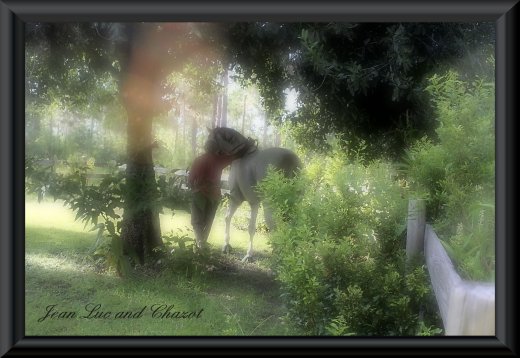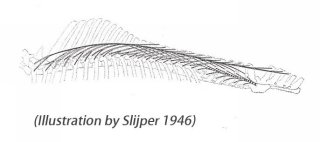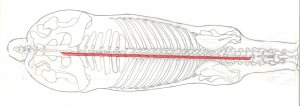Chazot Thoughts 62
Chazot Thoughts 62

“The movement starts in the mind; not in the legs,” (The author is an 80 years old man that I would gladly honor but I don’t know his name).
We both read the quote simultaneously and we had the same thought; “The ones who focus on the legs don’t use their brain”. The only difference is that I was referring to us horses and he was referring to riders.
We can move our legs independently of our vertebral column but we are then dysfunctional. Instead, sound and efficient locomotion demands proper coordination between lateral bending and rotation of our thoracolumbar spine and limbs movements. Many of us adapt to excessive load on the forelegs modifying the front limbs kinematics. At the trot for instance, our font limbs act as springs propelling our body upward. When the load on our front legs exceed the propulsive capacity of our front limbs tendons, muscles and ligaments, we use instead the front legs as struts, vaulting the weigh form one front limb over the other. We lose of course our capacity of suspension and balance control. I used to move like that, flat and uncomfortable. I did not like it, but it is how I instinctively adapted to excessive load on my forelegs. As he guided my mind toward better use of my thoracolumbar spine, I gradually understood why I elected to move this way and why it was uncomfortable. We don’t have much understanding of the future. We adapt to situations such as heavy load on our forelegs searching for instant relief. We do not understand that the compromise might further damage our front limbs; structures over time. He was riding me thinking, “This is not a good solution; you are too powerful and heavy. Your front hooves as well as your front limbs’ structures cannot deal with so much weight. I need teaching your authentic balance.”
It was totally different from the traditional concept of balance. The so-called “half halt” that jockeys were using during my training on the race track was supposed to teach me balance shifting some weight back over my haunches. I never felt any backward shift of my weight over my haunches as they pretended. I just braced my neck against their hands action. They were using a lot of different hands action that they referred to as half halt, but basically, they were pulling on one rein or two. The only moment half halt balanced me over my hind legs is when, annoyed by their pulling hands, I decided to rear. That is when I understood what they mean by shifting the weight backward. They were talking about their own weight as they were flat on their back behind my hind legs when my front legs came back on the ground. He later told me that, while he sympathizes with my interpretation of half halt, it was not yet accepted as the classical definition.
He did not teach me balance acting front to back. He educated my brain to further control my back muscles. He taught me how to convert, through the main muscles of my back, the thrust generated by my hind legs into horizontal forces, forward movement, and upward forces, balance control. I remember the main sentence of one of the first dynamic study about our thoracolumbar column mechanism. “An initial thrust on the column is translated into a series of predominantly vertical and horizontal forces which diminish progressively as they pass from one vertebrae to the next”. (Richard Tucker-1964). There has been a considerable evolution in knowledge since Tucker’s dynamics study, but the quote kind of described what he did. Interestingly, Slijper’s drawing (Illustration by Slijper 1946) 
 of our main back muscles, the longissiumus dorsi group, which was created in 1946, is more accurate than the drawings regularly published in modern days. The dumbing down of America, published by Ray Williams (2014) does have a political reason; it ensures control to a small group of politicians and finance persons. As well, the dumbing down of our anatomy is about control. Old theories such as the driving seat, stretching, relaxation, resist actual understanding of our vertebral column mechanism because actual knowledge contradict the institution. Simplistic illustrations are promoted by the ones who do not want to think higher than our legs so they can keep selling their antiquated theories.
of our main back muscles, the longissiumus dorsi group, which was created in 1946, is more accurate than the drawings regularly published in modern days. The dumbing down of America, published by Ray Williams (2014) does have a political reason; it ensures control to a small group of politicians and finance persons. As well, the dumbing down of our anatomy is about control. Old theories such as the driving seat, stretching, relaxation, resist actual understanding of our vertebral column mechanism because actual knowledge contradict the institution. Simplistic illustrations are promoted by the ones who do not want to think higher than our legs so they can keep selling their antiquated theories.
He did not teach me how to control each vertebra, starting by the lumbar forward. He knows that the school of thought pretending that each vertebra can be move and control separately is unrelated to actual knowledge. Instead, he guided my central nervous system toward a progressively more sophisticated control of my back muscles. It was a simple problem at first, like holding the same cadence without any support on the bit doing the Pignot jog. Today, when I think retrospectively about these trotting sessions, I am amused by the fact that at this time, I found this elementary control quite difficult. Today, I am exploring piaff and passage and it is basically the same coordination of my back muscles but at a much higher level of sophistication.
I remember years ago, I found the right coordination during a Pignot jog bouncing effortlessly. He patted me thinking, “You just made your first steps toward the Piaff.” Listening to every horse telling me about the suffering that they endured while learning the piaff, I could not believe that it could be that easy. Today I can state that it is that easy, as long as my body is properly coordinated. In fact, he does not ask me for the piaff. He helps me coordinating my body for greater mastery of forces and balance. I am a horse, so I react protecting whatever contraction or muscular difficulty that I have and he guides my brain toward superb coordination of my physique. When I feel ready, I explore the piaff and the passage and he tells me if I was very good or just good. When I hear about these stories of trainers activating our limbs with a whip or other utensils in vogue, I wonder, what these peoples think? Now I know that the problem is precisely that they don’t think. “The ones who focus on the legs don’t use their brain”.
Chazot
IHTC Course Online and via mail



 twitter
twitter facebook
facebook google
google pinterest
pinterest myspace
myspace linkedin
linkedin